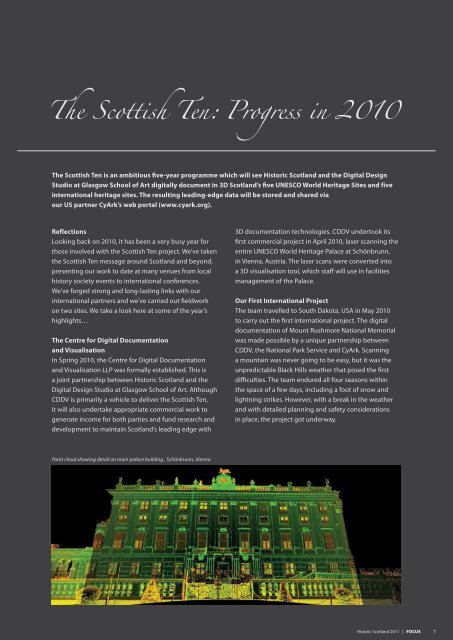informing the conservation of the built env ironment - Historic Scotland
informing the conservation of the built env ironment - Historic Scotland
informing the conservation of the built env ironment - Historic Scotland
You also want an ePaper? Increase the reach of your titles
YUMPU automatically turns print PDFs into web optimized ePapers that Google loves.
The Scottish Ten: Progress in 2010<br />
The Scottish Ten is an ambitious five-year programme which will see <strong>Historic</strong> <strong>Scotland</strong> and <strong>the</strong> Digital Design<br />
Studio at Glasgow School <strong>of</strong> Art digitally document in 3D <strong>Scotland</strong>’s five UNESCO World Heritage Sites and five<br />
international heritage sites. The resulting leading-edge data will be stored and shared via<br />
our US partner CyArk’s web portal (www.cyark.org).<br />
Reflections<br />
Looking back on 2010, it has been a very busy year for<br />
those involved with <strong>the</strong> Scottish Ten project. We’ve taken<br />
<strong>the</strong> Scottish Ten message around <strong>Scotland</strong> and beyond,<br />
presenting our work to date at many venues from local<br />
history society events to international conferences.<br />
We’ve forged strong and long-lasting links with our<br />
international partners and we’ve carried out fieldwork<br />
on two sites. We take a look here at some <strong>of</strong> <strong>the</strong> year’s<br />
highlights…<br />
The Centre for Digital Documentation<br />
and Visualisation<br />
In Spring 2010, <strong>the</strong> Centre for Digital Documentation<br />
and Visualisation LLP was formally established. This is<br />
a joint partnership between <strong>Historic</strong> <strong>Scotland</strong> and <strong>the</strong><br />
Digital Design Studio at Glasgow School <strong>of</strong> Art. Although<br />
CDDV is primarily a vehicle to deliver <strong>the</strong> Scottish Ten,<br />
it will also undertake appropriate commercial work to<br />
generate income for both parties and fund research and<br />
development to maintain <strong>Scotland</strong>’s leading edge with<br />
3D documentation technologies. CDDV undertook its<br />
first commercial project in April 2010, laser scanning <strong>the</strong><br />
entire UNESCO World Heritage Palace at Schönbrunn,<br />
in Vienna, Austria. The laser scans were converted into<br />
a 3D visualisation tool, which staff will use in facilities<br />
management <strong>of</strong> <strong>the</strong> Palace.<br />
Our First International Project<br />
The team travelled to South Dakota, USA in May 2010<br />
to carry out <strong>the</strong> first international project. The digital<br />
documentation <strong>of</strong> Mount Rushmore National Memorial<br />
was made possible by a unique partnership between<br />
CDDV, <strong>the</strong> National Park Service and CyArk. Scanning<br />
a mountain was never going to be easy, but it was <strong>the</strong><br />
unpredictable Black Hills wea<strong>the</strong>r that posed <strong>the</strong> first<br />
difficulties. The team endured all four seasons within<br />
<strong>the</strong> space <strong>of</strong> a few days, including a foot <strong>of</strong> snow and<br />
lightning strikes. However, with a break in <strong>the</strong> wea<strong>the</strong>r<br />
and with detailed planning and safety considerations<br />
in place, <strong>the</strong> project got underway.<br />
Point cloud showing detail on main palace building , Schönbrunn, Vienna<br />
<strong>Historic</strong> <strong>Scotland</strong> 2011 | FOCUS<br />
7











![Elgin Cathedral Wedding Brochure [pdf, 544kb] - Historic Scotland](https://img.yumpu.com/22301571/1/190x151/elgin-cathedral-wedding-brochure-pdf-544kb-historic-scotland.jpg?quality=85)




